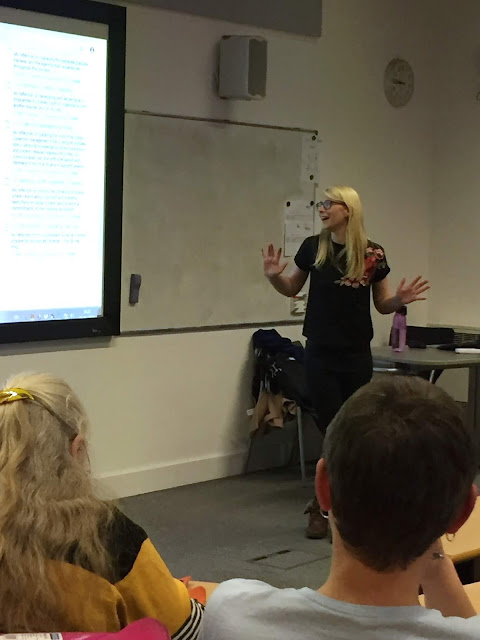Presented by Kirsty Franks, candidate support officer for CILIP South-East
Eighteen people came along to Kirsty’s talk, held
at the Reading University Whiteknights campus branch of the Henley Business
School.
Kirsty guided us, very clearly and usefully, through the following broad
areas in her talk:
- the steps to professional registration
- the structure of CILIP’s Professional Knowledge and Skills Base (PKSB)
- what is needed in a submission for registration
Most of the audience were considering chartership, but there was also at
least one (me!) wanting to embark on certification, and at least one
considering fellowship. The process follows the same steps at all levels –
though the content and approach changes – so much of what Kirsty told us was
relevant to everyone.
Once you’ve decided on the level you are aiming at the next step is to
find a mentor – everyone undertaking professional registration with CILIP needs
a mentor. There is a list of mentors available on the CILIP website. When you
make contact with someone it’s a good idea to tell them why you want them in
particular to act as your mentor. It’s important to check early on that your
timeframe will work for them, too: you should expect chartership to take one to
two years to complete.
Your mentor should never be your line manager, and ideally they should
be someone outside your own sector. When you find a mentor you both need to
decide whether the relationship will work – and at any point throughout your
registration journey you (or they) can decide that you need a new mentor. That
can be for any number of good reasons, so this shouldn’t be a cause of stress
to either party in the relationship.
Kirsty explained that the PKSB identifies different areas of
professional competence for information professionals. For professional
registration, at any of the three levels, a candidate should identify about ten
areas where they want to develop. For the registration process, candidates need
to chart that development. A thread throughout the talk was the importance of
showing development from where you begin, to where you get to when you submit,
and the need to capture your development as it happens, rather than retrospectively.
There are three compulsory PKSB areas that must be included in your
submission: ethics and values; wider library, information and knowledge sector
context; and wider organisation and environmental context. Candidates should
then select a number of other areas in which they want to develop. Kirsty suggests
that about seven areas – in addition to the three compulsory areas – is about
right. There are about ninety areas to choose from, thanks to the subdivisions
within the twelve numbered areas.
Kirsty’s tip was to start selecting your areas
somewhere other than 1 (Organising knowledge and information) and 2 (Knowledge
and information management), as these were the weightiest and therefore not the
most accessible place to start, and her advice is to aim for a nice range of
scores from 0s to 4s.
You should choose a mix of some core information skills and some more
generic skills, and you should be identifying your current rating, and your
ideal rating – but don’t get bogged down worrying about completely accurate
ratings. The PKSB is not itself assessed – it’s there to help you structure
your development.
For the areas on your PKSB that you want to improve you need to show
evidence of the work you have done to develop in those areas – for example,
visits to other libraries, work projects, things you have read, events you have
attended – and then show reflection on your development. Your written
reflections are the evidence you will need for the registration submission.
Kirsty’s advice is to upload your reflective writing immediately (it helps
protect you from the temptation to rewrite), but you can choose to upload
everything later. At some point, though, you will need to collect everything
you need in your online portfolio, for submission to your assessor.
For the submission you will need: your reflective-writing evidence (and
any other evidence you want to include), plus supporting documentation (an
annotated CV, a current job description, and a completed mentor-mentee form), your
initial and final PKSB assessments, and an evaluative statement. This last is
the only component that has a word limit – an absolute limit of 1000 words (but
keep in mind the assessor who has to read all your materials!). When you are
selecting evidence you probably want to choose the best two or three pieces of
reflective writing for each area. The layout of the submission is up to you.
There are some examples on the CILIP website that might help you decide on your
preferred display.
These were some of the tips and pointers I gleaned from the event. The
talk was further illuminated from Kirsty’s own experience of certification and
chartership, and there was an opportunity at the end of the session for
attendees to ask questions and to benefit further from Kirsty’s expertise in
supporting candidates through professional registration.
I would definitely recommend to anyone considering registration at any
level (or revalidation) that they seek out a similar event to hear more at
first-hand about the PKSB, the online submission process, and professional
registration more generally.
Sarah Mann
Chair, CILIP in the Thames Valley



No comments:
Post a Comment